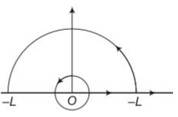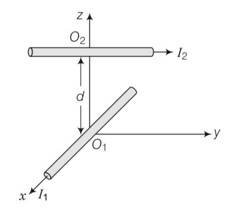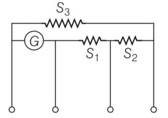Physics NCERT Exemplar Solutions Class 12th Chapter Four
Get insights from 102 questions on Physics NCERT Exemplar Solutions Class 12th Chapter Four, answered by students, alumni, and experts. You may also ask and answer any question you like about Physics NCERT Exemplar Solutions Class 12th Chapter Four
Follow Ask QuestionQuestions
Discussions
Active Users
Followers
New answer posted
5 months agoContributor-Level 10
This is a Short Answer Type Questions as classified in NCERT Exemplar
Explanation- general formula for magnetic field at center is
B=
B1= k for xy plane
B2= i for zy plane
B3= j for xz plane
After joining together B= (i+j+k)
New answer posted
5 months agoContributor-Level 10
This is a Short Answer Type Questions as classified in NCERT Exemplar
Explanation – in biot savart law, magnetic field B is parallel to idlr and idl have its direction along the direction of flow of current.
Here, for the direction of magnetic field at O2, due to wire carrying I1 current is B| parallel idl r or I k, but it is -j
So the direction at O2 is along y-direction.
The direction of magnetic force exerted at O2 because of the wire along x-axis
F= ilB=j (-j)=0
So the force is zero.
New answer posted
5 months agoContributor-Level 10
This is a Short Answer Type Questions as classified in NCERT Exemplar
Explanation – here, the condition of magnetic resonance is violated.
When the frequency of radio frequency field were doubled, the time period of the radio frequency field were halved. Therefore, the duration in which particle completes half revolution inside the dees, radio frequency completes the cycle.
Hence, particle will accelerate and decelerate alternatively. So the radius of path in the dees will remain same.
New answer posted
5 months agoContributor-Level 10
This is a Short Answer Type Questions as classified in NCERT Exemplar
Explanation- yes, the magnetic force differ from inertial frame to frame. The magnetic force is frame dependent.
The net acceleration which comes into existing out of this is however, frame independent for inertial frames.
New answer posted
5 months agoContributor-Level 10
This is a Short Answer Type Questions as classified in NCERT Exemplar
Explanation- dW=F.dl=0
As dl = vdt
dW= Fvdt
dW= f.v=0
New answer posted
5 months agoContributor-Level 10
This is a Long Answer Type Questions as classified in NCERT Exemplar
Explanation- iG (G) = (I1-IG) (S1+S2+S3) for I1= 10mA
iG (G+S1) = (I2-IG) (S2+S3) for I2= 100mA
iG (G+S1+S2) = (I3-IG) (S3) for I3= 1A
S1= 1W, S2= 0,1W and S3= 0.01W
New answer posted
5 months agoContributor-Level 10
This is a Long Answer Type Questions as classified in NCERT Exemplar
Explanation- B (z) points in the same direction on z-axis and hence, J (L) isa monotonically function of L so B.dl = B.dl as cos 0 = 1
(b) but when L
So B 1/r3
(c) the magnetic field due to a circular current carrying loop of radius in the xy plane with centre at origin at any point lying at a distance of from origin.

B=
Z=Rtan
dz=Rsec2
=
New question posted
5 months agoNew answer posted
5 months agoContributor-Level 10
This is a Long Answer Type Questions as classified in NCERT Exemplar
Explanation- B (z) points in the same direction on z-axis and hence, J (L) isa monotonically function of L so B.dl = B.dl as cos 0 = 1
(b) but when L
So B 1/r3
(c) the magnetic field due to a circular current carrying loop of radius in the xy plane with centre at origin at any point lying at a distance of from origin.

B=
Z=Rtan
dz=Rsec2
=
New answer posted
5 months agoContributor-Level 10
This is a Long Answer Type Questions as classified in NCERT Exemplar
Explanation- as we know magnetic moment = nIA
For equilateral triangle M= nIA= 4I ( )
M= Ia2
For square, n=3 so total length of wire is 12a
M= nIA= 3I (a2) = 3Ia2
For regular hexagon of side a, n=2 so total length = 12a
M= nIA=2 ( )= 3 a2I
Taking an Exam? Selecting a College?
Get authentic answers from experts, students and alumni that you won't find anywhere else
Sign Up on ShikshaOn Shiksha, get access to
- 65k Colleges
- 1.2k Exams
- 679k Reviews
- 1800k Answers


